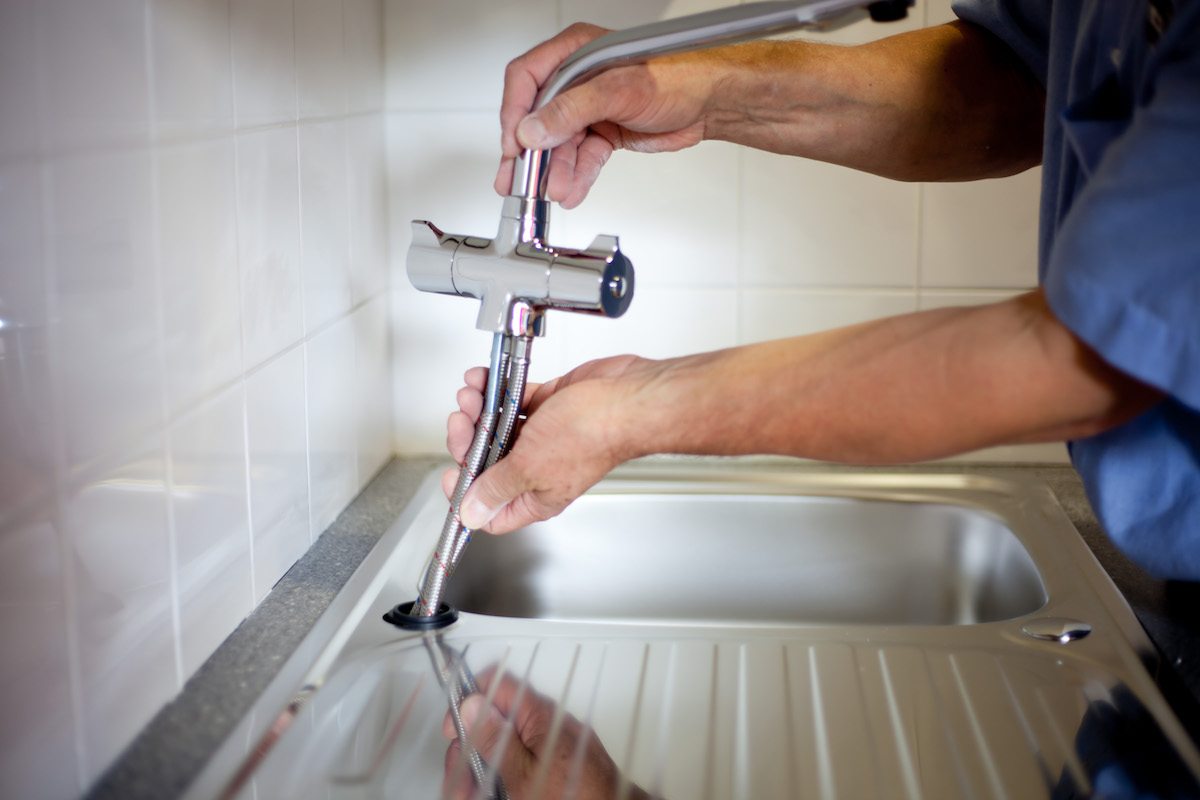

We may earn revenue from the products available on this page and participate in affiliate programs. Learn More ›
Has your old kitchen faucet seen better days? Whether yours is leaking water or is simply outdated, replacing a kitchen faucet is among the more popular do-it-yourself projects in the grand scheme of a full kitchen renovation.
Unfortunately, it’s not always as simple as it sounds, swapping out an old chrome faucet for one with a trendy matte black finish. The entire replacement task might go without a hitch, but because faucet configurations (and under-sink conditions) vary, chances are you’ll run into a snag or two during the process.
If this task has been on your to-do list for some time, keep reading to learn how to replace a kitchen faucet and be ready to take on potential obstacles that may pop up.
What to Know Before You Replace a Faucet
Replacing a kitchen faucet may be among the easier kitchen updates that many DIYers can do in an afternoon, but it’s important to take time to plan the project thoroughly for optimal success. When swapping an old faucet for the same type of faucet, the project could prove to be simple. For those who are installing a different type of kitchen faucet, there’s more to consider and execute.
By knowing what to expect—and what could potentially go wrong—you can avoid common pitfalls and recognize when it’s time to throw in the towel and call a plumber. However, before you learn how to replace a kitchen faucet, there are a few things to consider:
- What type of faucet is being replaced? By selecting the same type and configuration, there are fewer opportunities for challenges.
- Do you have experience working on a plumbing project? If you are a regular DIYer but have never attempted a plumbing project, this may be a good one to try. It can be fairly straightforward. However, if the project begins to grow beyond your abilities, it’s a good idea to hire a professional.
- How much time have you allocated? A kitchen faucet is an essential part of most homes. Without it working, daily activities can become more difficult. If you don’t have enough time to complete the entire project, wait until you do have enough time. This isn’t a project that can be easily set aside and completed later.
Tools & Materials
Bobvila.com may earn a commission from purchases made through these links.
Step 1: Select a compatible replacement faucet.
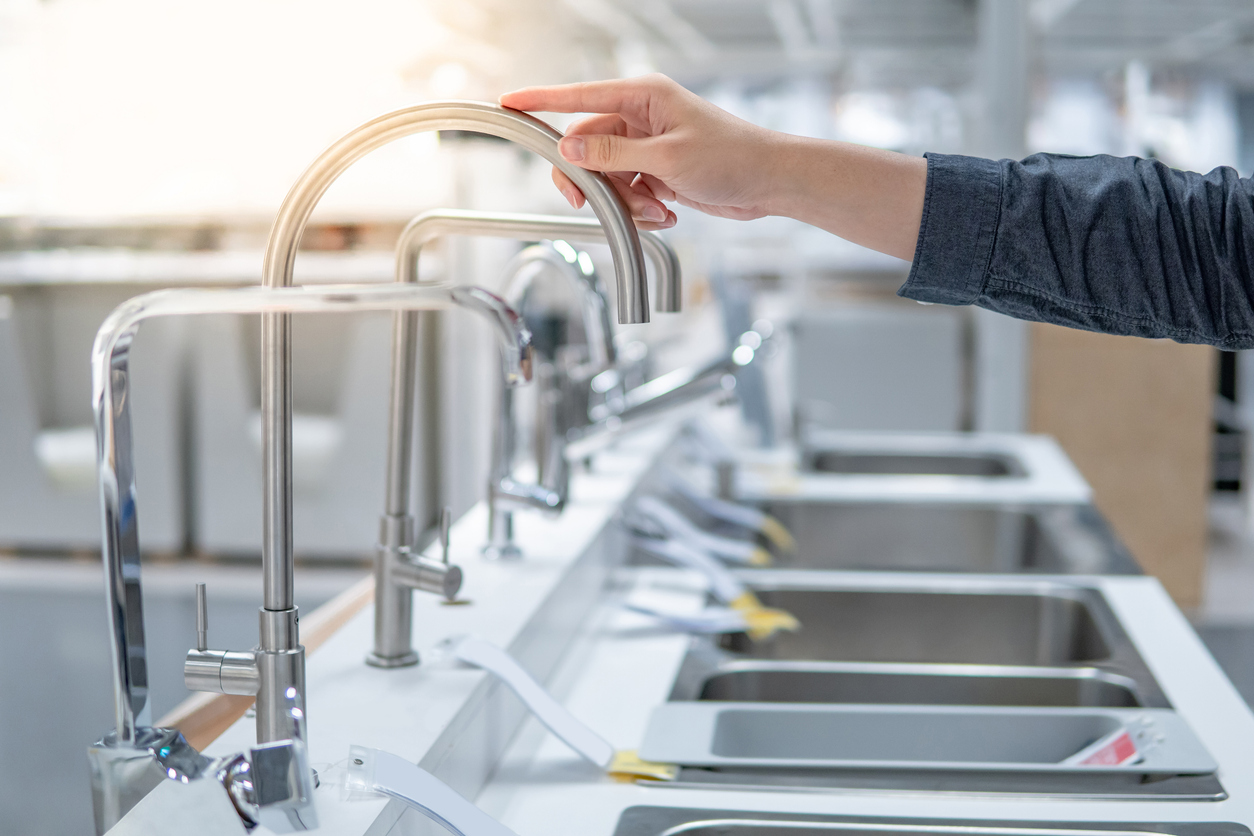
Before you head to the home improvement center to buy a faucet based simply on its shape and finish, get to know your current sink hardware. A typical, two-handle kitchen faucet installs over a set of three holes, with the two outside holes usually being 8 inches apart.
Installation of the replacement faucet will go the smoothest when you select one that fits the same hole configuration. Updating to a stylish single-handle faucet that requires only one installation hole when you have three is still possible. For this, you’d need to purchase a separate base plate, called an “escutcheon plate,” that matches the finish of the new faucet and extends long enough to cover up the unused holes.
In order to make sure your new faucet will be an easy match for your sink, look underneath the sink to check the locations of the holes and the connections. (If you don’t know where to begin in choosing a new kitchen faucet, our tested guide to the best kitchen faucets is a great starting point.)
Step 2: Before replacing a kitchen faucet, shut off the water valves.
After gathering the supplies and the new faucet, shut off the water to the existing faucet. Most of the time this is a cinch, accomplished by simply twisting the On/Off valves located under the sink that control the hot and cold water supply lines (connected to the underside of the faucet) to Off, using just your fingers.
If your existing faucet is more than a few years old, it’s not unusual for the valves to be stuck or rusted, making them virtually impossible to budge by hand. Before you attempt to loosen a stuck shutoff valve, it’s a good idea to shut off your home’s main water valve (often located inside a basement or crawlspace where the water line enters the house). If you can’t locate the main valve, you can use pliers to turn off the water at the meter (located in your yard beneath a small manhole-like cover).
With the water supply off, apply heat to the valve with a hair dryer to loosen the valve enough that you can close it. Alternately, use locking pliers to grab the valve and gently coax it to the Off position. However, excess twisting pressure could break the valve and/or the supply line. With the water supply off, a break won’t cause water to shoot out and flood the floor or cabinet.
Step 3: Prepare your workspace.
Of all the repair projects you can undertake around your home—even the ones such as painting baseboards where you have to bend and stoop or cleaning out gutters where you have to climb and stretch—few of them are as uncomfortable as trying to wiggle into the confined space under a kitchen sink. In addition to crawling into the cabinet to see where the faucet attaches to the countertop, you’re also lying across an uneven surface: The inside floor of the cabinet is generally a few inches higher than the kitchen floor, so your back has to contort to the difference, which never feels good.
A little trick to ease the discomfort is to insert a small sheet of plywood inside the cabinet. The sheet should be narrow enough to fit through the door’s opening, but wide enough to lay on and long enough to support your back and rear end. Use six to eight quart-size cans of paint (or cans of similar size) to support the end of the plywood sheet that extends out into the kitchen—that should give you a flat surface on which to lie as you replace the faucet.

Tried-and-True Advice
“One of my least favorite things in home improvement to do is crawl into a base cabinet on my back. But, we have to go where the work is and that’s where sink faucets are. I like a piece of foam flooring to cushion my back. I also like a head lamp like LiteBand because it casts an orb of light and minimizes shadows. Because a soap dispenser is often part and parcel with a faucet replacement, I like to keep a basin wrench handy as well.”
—Mark Clement, Contributing Writer
Step 4: Remove the old faucet.
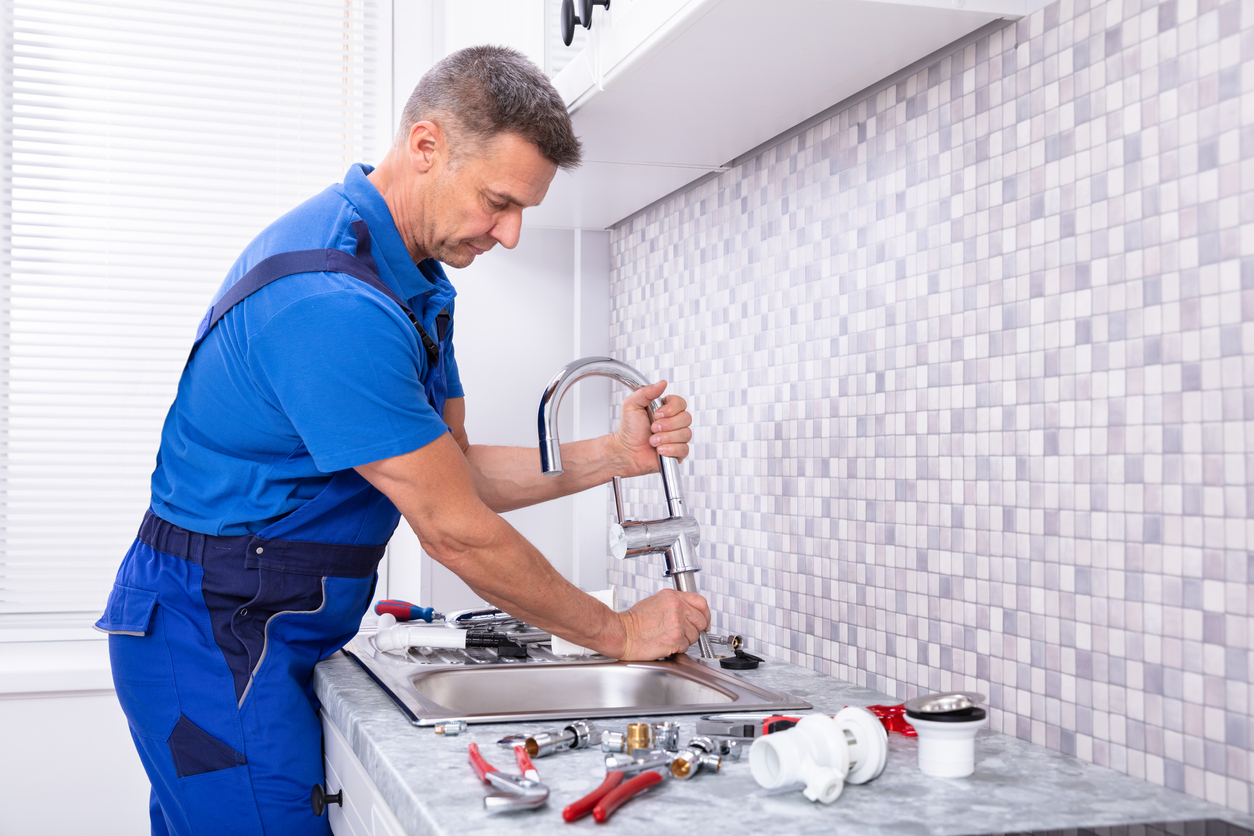
Once the water is off, removing the old faucet is a matter of loosening the nuts that hold it in place (from beneath the sink) and then lifting the faucet out of the holes. Unfortunately, this step can be easier said than done.
The space under the sink where the faucet attaches is often narrow and, due to its location, pitch black. Have an adjustable wrench close at hand for loosening the nuts. You’ll want a bright work light, such as the DEWALT 20V MAX LED Work Light, to illuminate the area.
Like the shutoff valves, the nuts holding the faucet in place can be stuck or rusted. If you run into this problem, try brushing away as much corrosion as possible with a wire brush. Follow the brushing by spraying penetration oil, such as Liquid Wrench, on the nuts to help dissolve the corrosion.
It can take from 30 minutes to overnight for the oil to work. If you try loosening the nuts again with the wrench and they still won’t turn, they will have to be cut off with a reciprocating saw or a hacksaw. Some do-it-yourselfers opt to call a plumber at this point to help with the kitchen faucet removal.
Step 5: Drill additional holes in the sink if necessary.
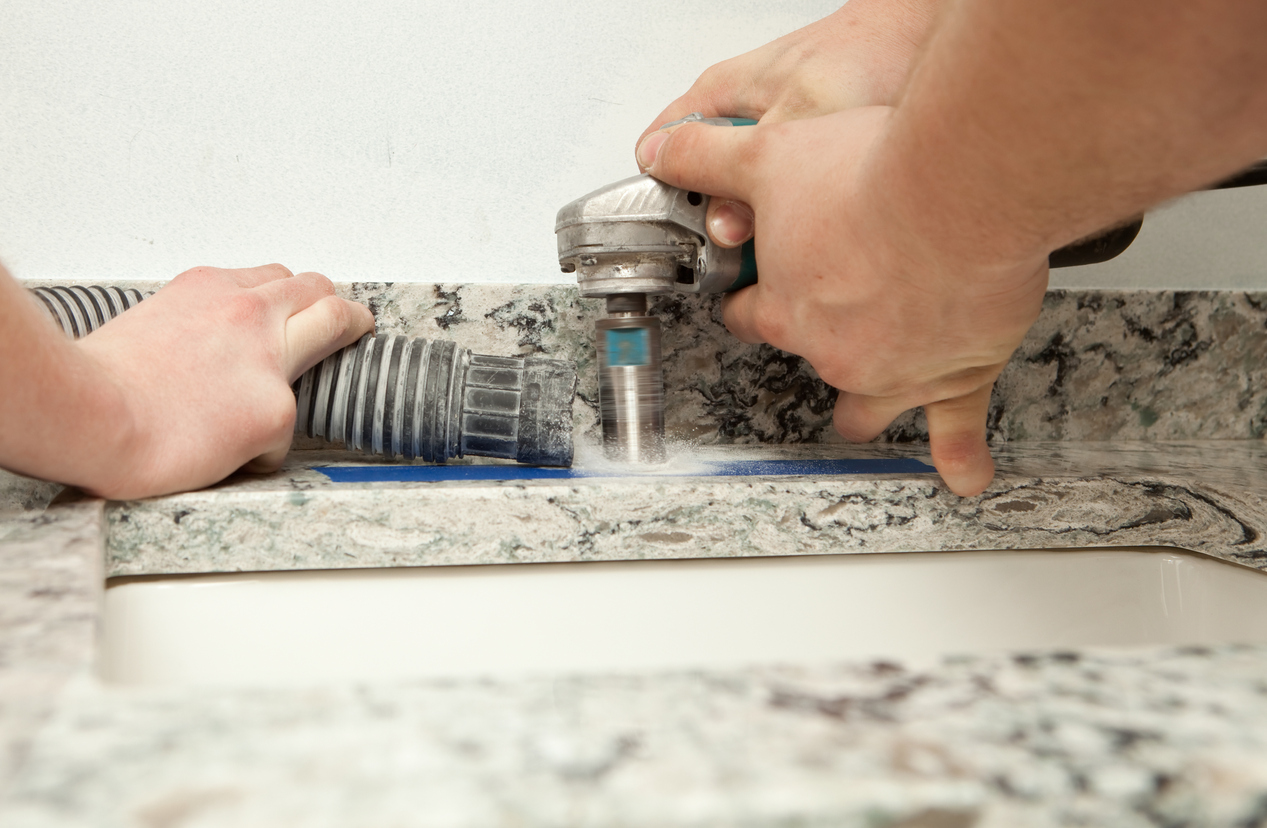
With the old faucet removed, double-check the number of holes in the sink and the distance between the center of the left-most hole to the center of the hole on the far right. This is known as measuring “on center” (or “OC”), and is the industry standard for measuring sinks’ holes.
If the new faucet also means changing the holes or increasing from one handle to two handles, additional holes are needed. In this case, you can bore new holes in the sink (or in the countertop behind, depending on your existing faucet configuration) to accommodate the new faucet.
While new holes can be accomplished by an experienced DIYer, boring new holes in a granite or quartz sink or countertop are usually best done by a countertop contractor who has the equipment to bore the new holes cleanly without cracking the countertop material.
Before drilling, cover the area with painter’s tape and then mark the center of each hole. Then, drill a pilot hole. Using a hole saw drill bit, put the center of that bit on the pilot hole and make the hole.
Step 6: Install the escutcheon (deck) plate.

If you are replacing a three-hole faucet with a one-hole faucet, it’s time to place the escutcheon plate over the extra holes. Follow the manufacturer’s instructions to make sure the plate is watertight. You may need to first place an included rubber gasket over the holes, and then put the plate on top. Often the plate will need to be caulked or sealed with plumber’s putty.
Step 7: Put the new faucet line through the hole.
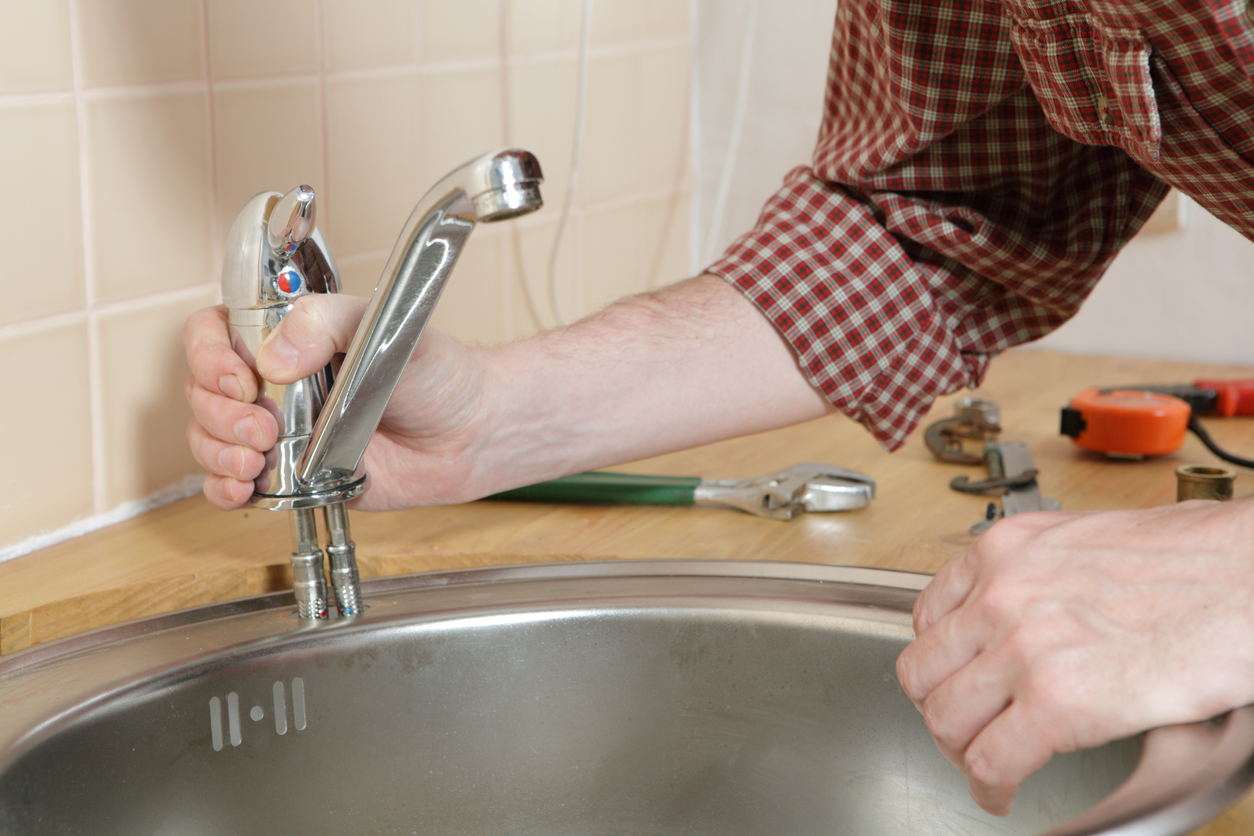
Following the hole, feed the faucet line through and adjust it so it sits in the desired position. Using the included hardware, attach the faucet with the washers and nuts underneath the counter. Double-check the position of the faucet from above, and then tighten the nuts and included brackets until the faucet is secure.
Step 8: Connect the water supply.

Some new faucets come with attached flexible tubing for the supply lines, each labeled hot or cold. If yours doesn’t, then you need to attach them. Wrap the threads counterclockwise with Teflon tape before connecting each to the hot and cold water supply valves under the sink.
Step 9: Check the installation for leaks and clean up.
Turn the water supply line back on very slowly, being careful to check for leaks. Make adjustments, like tightening any connections and checking the Teflon tape, before testing again.
When You Should Call a Plumber
What should be a 2-hour faucet-replacement job can quickly turn into an entire weekend plumbing project if you are faced with surprises along the way. If you don’t have plumbing experience or encounter a complication, it’s often better to call a plumber than to attempt to remove and reinstall additional plumbing elements.
- You have a wall-mounted faucet. Faucets that attach directly to the wall behind the sink (and pot filler faucets, which usually mount behind the stove) are among the newest and trendiest faucets going. The bad news is that installing a wall-mount faucet is one of the most involved replacements a homeowner can attempt. Making the switch from a sink-mounted (or countertop-mounted) faucet to a wall-mounted faucet involves opening up the wall behind the sink and running new water-supply lines, which is definitely a job for a plumber. Plus, to get rid of the faucet holes left behind, they will need to replace your sink or countertop.
- You need to remove additional plumbing to access the old faucet. Sometimes, you simply can’t wedge your body far enough beneath the sink to have a clear path to reach the nuts holding the old faucet in place. When it looks like you’ll have to remove additional plumbing like the sink drain trap or the garbage disposal, it can start to get more complicated in a hurry. A professional plumber can help.
- You don’t have enough time to complete the project. For those who don’t have a lot of experience with plumbing or do not have the extra hours to spend learning how, it may be a good idea to call a plumber for help.
- You installed the new faucet, but it’s leaking and you don’t know why. If you’ve successfully installed the new faucet, but testing it uncovered a leak, it’s time to investigate and fix the issue. If you’ve checked all of the connections, and can’t figure it out, it’s probably best to ask for help from a professional plumber. A slow leak can cause a great deal of damage over time.
Final Thoughts
Learning how to replace a kitchen faucet is one of the easier kitchen remodeling updates that DIYers can accomplish to freshen up their homes. While a new faucet can be installed in just a few hours, the type of faucet being swapped affects the amount of time, number of tools needed, and whether professional help may be optimal.
If you are updating a single-mount faucet with another single-mount, it is the easiest scenario. For those who want to change from a single-mount to a double-mount, holes will need to be created to accommodate the new faucet. Changing from a double-mount to a single-mount is also possible, but it requires a base plate to cover the holes that are no longer needed.

FAQs
If you already own a basic set of tools, replacing a kitchen faucet with an inexpensive faucet can cost a few hundred dollars. The needed budget can grow if a drill or luxury faucet is needed.
In addition to the cost of the faucet, expect to pay an additional $150 or more for a plumber’s labor to install a faucet.
Faucets can perform well for a decade or more if the faucet has been cleaned and maintained regularly. Over time, mineral deposits accumulate and leaks can begin to occur. If these issues aren’t fixable and it is not performing adequately, it may be time to replace the faucet.
